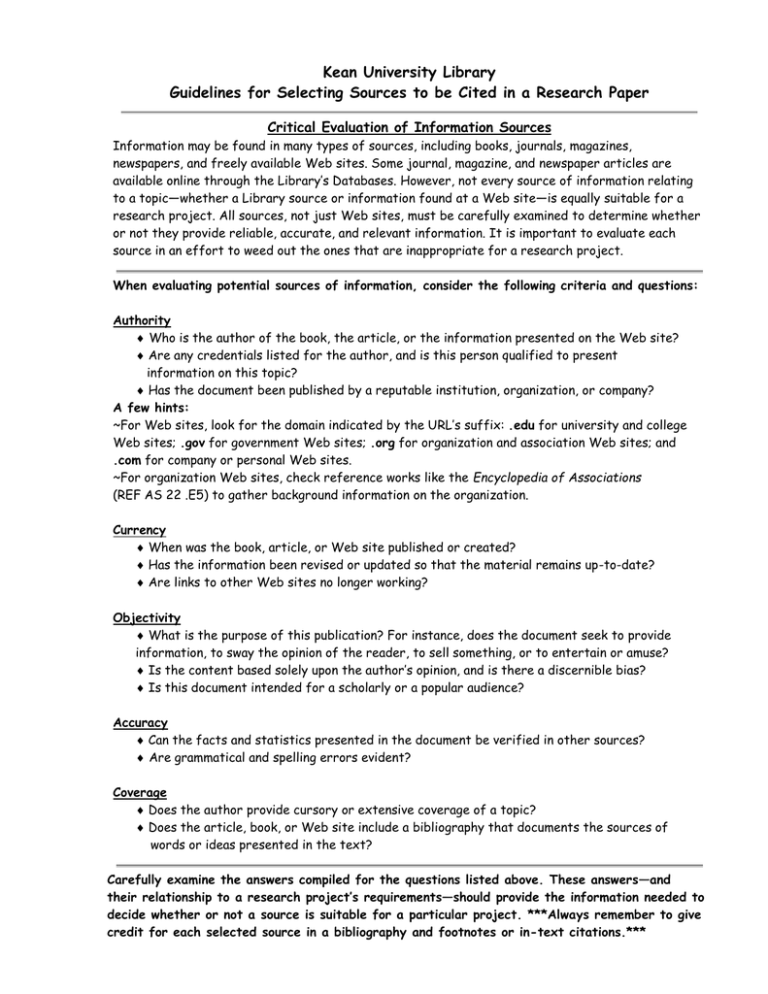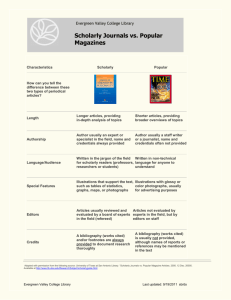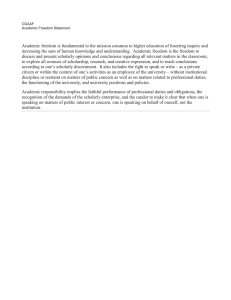Kean University Library Critical Evaluation of Information Sources
advertisement

Kean University Library Guidelines for Selecting Sources to be Cited in a Research Paper Critical Evaluation of Information Sources Information may be found in many types of sources, including books, journals, magazines, newspapers, and freely available Web sites. Some journal, magazine, and newspaper articles are available online through the Library’s Databases. However, not every source of information relating to a topic—whether a Library source or information found at a Web site—is equally suitable for a research project. All sources, not just Web sites, must be carefully examined to determine whether or not they provide reliable, accurate, and relevant information. It is important to evaluate each source in an effort to weed out the ones that are inappropriate for a research project. When evaluating potential sources of information, consider the following criteria and questions: Authority Who is the author of the book, the article, or the information presented on the Web site? Are any credentials listed for the author, and is this person qualified to present information on this topic? Has the document been published by a reputable institution, organization, or company? A few hints: ~For Web sites, look for the domain indicated by the URL’s suffix: .edu for university and college Web sites; .gov for government Web sites; .org for organization and association Web sites; and .com for company or personal Web sites. ~For organization Web sites, check reference works like the Encyclopedia of Associations (REF AS 22 .E5) to gather background information on the organization. Currency When was the book, article, or Web site published or created? Has the information been revised or updated so that the material remains up-to-date? Are links to other Web sites no longer working? Objectivity What is the purpose of this publication? For instance, does the document seek to provide information, to sway the opinion of the reader, to sell something, or to entertain or amuse? Is the content based solely upon the author’s opinion, and is there a discernible bias? Is this document intended for a scholarly or a popular audience? Accuracy Can the facts and statistics presented in the document be verified in other sources? Are grammatical and spelling errors evident? Coverage Does the author provide cursory or extensive coverage of a topic? Does the article, book, or Web site include a bibliography that documents the sources of words or ideas presented in the text? Carefully examine the answers compiled for the questions listed above. These answers—and their relationship to a research project’s requirements—should provide the information needed to decide whether or not a source is suitable for a particular project. ***Always remember to give credit for each selected source in a bibliography and footnotes or in-text citations.*** Differences among Scholarly, Popular, and Trade Sources Characteristics of Scholarly Journals Articles written by school Characteristics of Popular Magazines “Serious” appearance with few bright colors. Articles are written by scholars, whose academic credentials are mentioned. Prior to publication, articles are typically “peer-reviewed” by other experts in the academic discipline. Articles are meant to be read by other scholars and students. Articles contain scholarly language relating to the academic discipline. Articles represent a form of scholarly communication as authors report on their scholarly research. Articles end with a list of references to other scholarly journal articles and books. “Glossy” appearance with photographs, advertisements, and catchy article titles. Articles are written by journalists and magazine staff writers. Articles are meant to be read by the general public. Articles contain language for the layperson. Articles seek to entertain or to report on current events and topics of general interest. Articles are usually relatively brief. Articles usually do not include a bibliography. Examples include: Journal of Interdisciplinary History Developmental Psychology American Journal of Nursing Examples include: Newsweek Fortune The Atlantic Monthly The New Yorker Characteristics of Trade Journals “Glossy” appearance with advertisements relating to a particular industry. Articles are written by industry experts and professional staff writers. Articles are meant to be read by workers in the industry. Articles report on news and trends relevant to the industry. Articles usually do not include a bibliography. Examples include: Advertising Age Graphic Arts Monthly Management Today Copyright © 2007. Kean University Library. Compiled by Linda Cifelli. December 2007.


